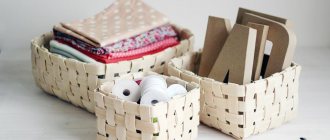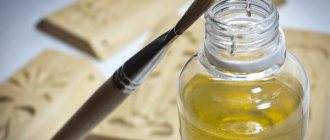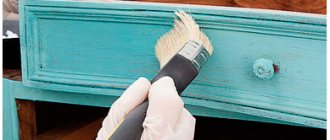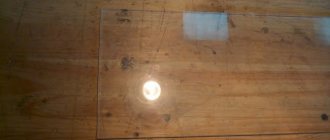Interior doors made of wood are not cheap, they look presentable, solid and are quite durable. But over time, their appearance deteriorates, and noticeable damage appears on the surface. Restoring interior wooden doors will help restore the coating and restore attractiveness. You can do this work with your own hands. It is not difficult. You just need to know the recovery methods and take into account some nuances. Then the restored product will look no worse than a new one from the store.
Preparation
Whatever method you choose to update an old interior door, you will need to carry out a number of preparatory work. Usually old painted specimens are going to be decorated. Painting is usually amateurish, so there are more than enough unevenness, sagging and other minor defects. They all need to be leveled.
Remove the door leaf from the hinges and lay it on a flat surface. You can - on a trestle or a table. We take wood putty (even if they are made of chipboard or plywood) and cover all the holes, chips and depressions with it. After drying, we move on to the next stage - sanding.
We buy wood putty
We take sandpaper with coarse and fine grains. We process to achieve a smooth surface. If you work manually, it takes a lot of time and effort. With a hand sander, work moves faster. If painting is planned next, we try to achieve as smooth a surface as possible. If you plan to decorate with wallpaper, fabric, self-adhesive film, you don’t have to bring it to perfection, but it should still be exactly right.
Hand sanding takes a long time
Next, remove the dust and wash off the residue with water and diluted dishwashing detergent. Dry it. Further actions depend on the selected update method. If you are going to glue fabric or wallpaper of any kind, you can prime the surface (with thinly diluted glue or a special primer). After the primer has dried, you can glue the selected type of decor or apply paint. By the way, if you are going to paint the doors, you need to select the same type of paint that was there before, otherwise you will have to remove everything to a clean base, and this is very difficult.
Possible defects
Restoration begins after determining the extent and type of damage. The defects of wooden doors of different designs may differ; to eliminate them, a suitable method is selected:
- Deformation of a multilayer door leaf. A curved product is almost impossible to close, or large gaps remain due to a loose fit to the frame. The defect is common for products made from several layers of wood. The reason is a violation of gluing technology, poor-quality material or intense exposure to moisture. Minor curvature is compensated by adjusting the frame. In case of severe bending, replace the top layer of sheathing to relieve stress.
- Peeling of covering sheets from the frame. The defect occurs as a result of the manufacturer using low-quality glue or when the recommended operating conditions are violated. It can be restored by re-gluing and then keeping the product under pressure. However, the solid frame and covering sheets react differently to moisture and temperature changes. When peeling, the decorative coating often cracks or breaks in pieces. Small cracks are hidden with putty. If the peeled sheet cannot be restored, it is replaced.
- Loosening of the glued door frame. The result of the defect is loose closure, as well as the formation of cracks. It can be assumed that the product itself is bent. To make the right decision, both structural elements are inspected. If the problem is in the box, it is strengthened by removing the trim.
- Door leaf skewed. Diagnosis begins with inspection of the loops. If the door is too loose, it may not close. If a misalignment is detected, which is often found on a frame where the elements are connected by a notch, leveling is done using wedges. Grooves are cut out in the corners of the structure and filled with glue. Wedges sharpened at an angle of 10° are driven in with a hammer until the frame is completely level.
- A slight increase in the gaps between the leaf and the door frame is likewise a defect. Heat escapes from the house through a loosely fitting sash, reducing the quality of sound insulation. The problem with small gaps is solved by gluing seals.
Renew old doors with wallpaper
The easiest and most affordable way to make old doors attractive is to use wallpaper. They do not necessarily have to be the same color as the walls, although this option is not excluded. First, prepare the canvas as described above, and then you can start finishing.
The procedure for wallpapering doors is as follows:
- dilute wallpaper glue according to the instructions on the pack;
- apply to the door leaf;
- glue the wallpaper, carefully taking care to remove bubbles (using a rubber roller or plastic spatula);
- We trim the edges using a wallpaper knife and a flat metal strip (it’s fashionable to use a large spatula);
- We wait for the wallpaper to dry.
Covering old doors with wallpaper is a good way to turn old ones into new ones.
Then you can continue decorating on top of the wallpaper or leave it as is. Below are some options on how you can update old doors using different types of wallpaper.
Photo wallpaper
Modern photo printing allows you to transfer three-dimensional images onto paper. It will turn out very beautiful. Moreover, you can print any image of your choice. In general, any. Photo printing is usually done by advertising agencies, sometimes by printing houses. Contact them, explaining what you need (have a flash drive with the selected design and the exact dimensions of the canvas on which you want to print the image). Having received the required image, we glue it on the door according to the method. described above.
Only three door options with photo wallpaper
Wallpaper with moldings
If you stick foam or polyurethane moldings and rosettes onto plain wallpaper, the style will completely change. This type of door is suitable for classic interiors or rooms; using a colorful background and a different form of moldings (with curves) can be decorated in Provence style.
The work is no different from the sequence described above. We take the prepared doors with a leveled surface, spread them with glue, and glue the wallpaper.
Renewing old doors with wallpaper
By leveling the panels with a rubber roller it is not difficult to achieve good results, but a certain number of small air bubbles remain. To remove them, take a special plastic spatula (any hardware store has them), and use it to finally remove the air from the center to the edges. Also, use this spatula to smooth the wallpaper joint, if there is one. It is quite possible to achieve that the joint will not be visible.
We expel the remaining air, after drying we glue decorative elements on the door
Trim the edges of the wallpaper with a wallpaper knife. This must be done before the wallpaper is softened by the glue, otherwise later it may “stretch” behind the blade and tear. Leave to dry. After 12 hours or a day - depending on the temperature and humidity in the room - you can continue decorating the old door.
Carefully apply the markings with a simple pencil. When everything is drawn, use a tape measure to measure the required length of the pieces of molding. We cut it off and file the edges at an angle of 45°. We take a suitable glue (PVA is possible) and carefully smear the back surface of the cut elements, glue them according to the markings, and leave them to dry.
Stylish new doors from old ones
Using the same principle, you can update old doors so that the style will be different. Several examples in the photo gallery.
You need to be able to play with contrasts
The edges of the wallpaper strips are trimmed with self-adhesive cord. It comes in silver or gold
Beautiful wallpaper with a matching pattern is the secret to the attractiveness of this door decor
These doors were first painted and then decorative elements were glued on
Nobody said that the entire surface of the door leaf should be covered with wallpaper. Classic outlines of inserts
Moldings were glued onto the painted doors, which were then painted with “gold” paint.
When is restoration necessary?
A wooden structure, for all its charm, may not be liked by the owner, or significant defects may be found on its surface. In such situations, there is no need to purchase a new door, because wood can be easily restored. At the same time, it is quite possible to cope on your own.
Cases when restoration of interior wooden doors is required:
- chips, cracks, scratches are noticeable on the surface, the integrity of the coating is compromised;
- Unsightly spots stand out against the background of the finish;
- the panel area has cracks;
- the surface has darkened;
- the appearance is lost due to damaged cladding;
- if glass and mirror inserts and other decorative elements are damaged;
- and finally, in the case when you just want change.
If interior or entrance doors have a complex design with decorative carvings or other elements, then it is better to contact professional wooden door repair specialists who will carry out the work efficiently and quickly. Otherwise, you can update it yourself using our tips.
Designer decoration of old doors
If you are interested in designer items, you can try turning it into an art object. The good news is that you don’t need to prepare it: the unevenness and sagging will be hidden under the design.
What kind of doors were there and how they can be made
The decorating process begins with the making of papier-mâché. Take egg trays, sprinkle them with water, knead them with your fist, trying to level the surface. They will tear during the process, this is normal and even good - we need small pieces. These almost flat fragments are glued onto the surface in any order using liquid nails or using a glue gun.
Creating decorative elements for the door
Next, we glue any junk with an interesting structure, unusual or regular shape. In our case, we found an old knitted string bag. It was cut into small pieces and also glued.
We glue decor on old doors
The items used are lids, rings, a small perfume bottle, a small non-working computer mouse, the remains of a mosaic, whatever comes to hand. You will need a lot of trash, you can collect it ahead of time.
The process of decorating an old door is in full swing
When most of the surface is “decorated”, take acrylic silver paint in cans (you need 2 pieces) and paint the decor well. When choosing paint, it is better to take an expensive one, in particular German, so that it does not crumble later.
Forging effect, an interesting option
Preparatory work
Their sequence is unchanged, regardless of what material the door is made of. What tools and devices will be needed will become clear during the initial inspection of the structure and analysis of existing defects. Then you can determine how to restore a wooden door. For metal analogues, all basic measures are identical, although the choice of restoration options is somewhat limited.
- A place is determined where it will be convenient to work on the door. The base must be strong and level so that the canvas does not “play” during work (the floor, an oversized countertop, a workbench - it is not difficult to determine an acceptable option).
- The sash is dismantled and laid on the prepared surface.
- All fittings are removed - hinges, handles, decorative trims, locks, inserts and the like.
- The canvas is washed thoroughly. The composition of the solution, the devices necessary for operation are selected based on the type of door to be restored - plastic, paneled, solid wood, and so on.
Decorating doors using decoupage technique
Romantic or “cheerful” door designs can be made using decoupage. To work you will need:
- napkins with a suitable pattern;
- PVA glue (about 200 ml);
- natural bristle brush;
- acrylic lacquer.
We prepare the canvas as described earlier. We prime and paint it in a suitable color. After the paint has dried, we begin decorating. Take a pack of napkins you like and separate the top layer, which has a pattern.
Separate the top layer of napkins with a pattern and tear them lengthwise into two parts
We tear napkins with a pattern lengthwise into three strips. We tear it, not cut it. We want a slightly uneven edge. Two strips on one side have a smooth edge; we put them to one side. We tear the middle part into squares. The best option is if they are 3-4 cm on a side.
Tearing napkins
Take glue, a brush, and a small container. In it we mix PVA with water in equal proportions.
We dilute the glue with water
Next, we start decorating the door with our own hands. We take a strip with a smooth edge and apply it to the area to be decorated (in this case, it is the center of the door leaf). We dip the brush in glue and begin to smooth the fragment in different directions. Wrinkles will form, but this is just a good thing - the finish will be more textured, so there is no particular need to even them out. When wet, napkins are very delicate and elastic, remember this when working and act carefully.
Carefully work with a brush dipped in PVA
Gradually we make a frame with one smooth edge. The second one comes out carelessly torn.
Making a frame on the door from napkins
Next, fill the middle with squares. The technique is the same.
Filling the middle of the “frame”
DIY door decor is almost finished
When the entire surface is filled, leave it for a day - wait until the PVA dries. Next, take acrylic varnish and cover our decor with a soft brush. To prevent it from smelling, we use a water-based varnish. It's a little more expensive, but it doesn't give you a headache.
This is what happens after the varnish dries
The beauty of decoupage is that we get beautiful things at minimal cost.
Varnishing
Next, you need to open the jar and stir the composition. This will eliminate the presence of air bubbles in the varnish. Then pour a small amount of paint into the prepared container. The door is first removed from the frame and installed horizontally.
The varnish is applied promptly to prevent transition between layers. It must be applied in an overlap. The number of layers is at least 3. Each of them must first dry. This takes about 12 hours.
Also note that varnishes from different manufacturers have different drying times.
Therefore, pay attention to what is written on the packaging. What to do when sagging and drips form? You can remove them with sandpaper
But such manipulations can be done on the first two layers. You cannot use sandpaper at the finish, otherwise the appearance will deteriorate.
Please note: while the layer is drying, the brush must be in a closed bag or in a jar of varnish. Otherwise, the product will crystallize and it will be impossible to work.
Decorating a door with self-adhesive film
Perhaps the easiest way is to update old doors using self-adhesive. All you need:
- the film itself,
- a spray bottle containing soap and water;
- plastic spatula or soft cloth;
- sharp knife (can be wallpaper).
This film is available in different versions - there is a plain matte or glossy one, there is a plain one with holographic patterns, a wood effect, there are even special ones for covering doors with photo printing applied.
Part of the range of self-adhesive films
Regardless of the type of film, it is glued in the same way. In this case, we decided to update the old doors using a photo printing option. One point: before gluing, remove handles, latches and other door fittings.
For the decor to be of high quality, the surface of the door must be clean, even and smooth. If you processed it with a sander before, try gluing a small piece of film. If it sticks well, everything is fine. If it “doesn’t stick,” you’ll have to prime the doors and then paint or varnish them to create a smooth surface.
Take a spray bottle and evenly wet the surface of the door.
Spray the doors
We shave the film, remove the protective layer from one of the corners, and also spray it. So, by wetting, we separate the protective paper from the top along the entire width of the film.
Separate the paper backing on the upper corner and moisten the film with water
You should get a strip 15-20 cm wide. Do not remove any more so that the film does not stick to the canvas. We apply the peeled part to the upper edge of the door leaf (or the area to be decorated), it quickly sticks. Try to apply it evenly right away, but the position can be corrected - that’s why we wet the surface so that the film could be moved. If you pull it, it moves little by little.
Apply the film to the upper edge of the door leaf and smooth it, removing air
After making sure that the canvas lies flat, take a plastic spatula (for wallpaper) and smooth the surface with it, moving from the center to the edges. The goal is to remove all the air. Since the surface is wet, this is not difficult - the water displaces the air.
Everything else is simple. We pull down the protective paper, peel off the strip, glue it and so on - to the very bottom of the door. If you glued the top part for a long time, the bottom part may dry out, so periodically check whether the doors are dry and spray again if necessary.
Cut off the excess
After all the film has been glued, use a sharp knife to cut off the excess along the edges. All that remains after this is to install the fittings.
This is how you can update old doors using film with photo printing
Required tools and materials
Restoring entrance doors is impossible without special tools and materials.
Before starting work, you need to check the availability of the following equipment:
- antiseptic impregnation;
- varnish, paint or stain;
- coating remover;
- primer, sealant;
- spatulas, a hair dryer for removing old paint;
- screwdrivers for dismantling structural elements;
- sandpaper of various textures for sanding;
- nails, hammer, screwdriver for attaching patches;
- brushes for applying paint, varnish;
- door fittings, lock, hinges.
Door decor with stencils
Old doors can be updated using printed drawings. It’s just a pity that not everyone has artistic talent. But in this case, the problem is solved with the help of stencils. You can draw them yourself, or you can find an image you like, print it on thick paper, cut out the design with a sharp knife, leaving jumpers in places. Now the stencil is ready.
The disadvantage of a paper stencil is that it doesn’t last long. If you need a “long-lasting” one, you need to transfer it to a transparent thick film. The technology for cutting out stencils for door decoration is shown in more detail in the video.
The drawing can be anything. Both geometric and floral, stylized images of animals, birds, and cartoon characters are popular.
Here are some options for small stencils
But they can also cover the entire area of the door leaf. It all depends on the style of the room and your desires.
You can update old doors using stencils. A repeating geometric pattern is also cute
Interesting effect
Using the same technique, you can decorate doors with glass. Many older doors have a regular glass insert. In order not to spend money on patterned ones, you can apply the pattern yourself.
Stencil on door glass
Possible problems
To know exactly how to restore old doors, you need to find out the existing problems. Most often, interior models suffer from mechanical damage and moisture.
The number one problem with plastic is scratches. You can hide them with soft polishing. If desired, you can apply a new coating, for example, a self-adhesive film.
Wooden interior doors often suffer from drying out due to temperature changes and moisture ingress. The canvas becomes cracked and warped. There may also be a problem with the coating itself. If it's paint, it may flake and crumble over time. If you used decorative overlays like laminate or MDF, be prepared that they will come off when in contact with moisture. Wood that is not properly treated will deteriorate and may become moldy. Then you need to clean the affected layer.
It is most difficult to restore interior doors made of fiberboard, since this material cannot be subjected to rough processing. As for chipboard, its main problem is delamination of the structure due to moisture ingress. You need to fill the gaps with glue and put the canvas under the press.
Chips and cracks appear on the doors during use.
How to make new doors out of old doors - photo ideas
One of the options for photo wallpaper on the door
Drawings with holographic effect
The colors can be “cheerful”
The combination of thin and thick stripes gives a voluminous effect
An option for those who know how to draw - painting on the door
You can use a map instead of wallpaper
Volume illusion
Two-color diamonds - doors are not boring
Door decor option for a classic interior
How to choose a successful design?
Doors must match the design of the room in color and structure. When the interior paintings are similar to each other, a feeling of integrity and completeness is created in the apartment. The door structure consists of more than just a leaf. The product is complemented by platbands, fittings, frames, and plinths. Each element must be harmoniously combined with the interior of the home.
The surface structure of the product emphasizes the taste of the owner of the house. The canvases are made of wood, veneer, laminate, glass, and metal. A wide choice of materials opens up great design possibilities.
Care Tips
In order for a veneered door leaf to last as long as possible and look like new, it must be properly looked after. It is forbidden to clean the veneer with abrasive materials, otherwise small scratches will remain on the coating and it will quickly lose its gloss. It is not advisable to install veneered doors in such a way that direct sunlight always falls on them. This will cause the cladding to fade; veneered doors will have to be updated quite often: apply varnish or paint.
It is allowed to wipe the veneer with a damp cloth, but it must be thoroughly wrung out. Literally washing with water; using the structure at high levels of humidity is prohibited. You also need to be careful when washing the floors, because the bottom of the door frame and sash will suffer from this.
Veneered doors, if properly cared for, will last for decades. Only in this case they cannot protect themselves from minor scratches and defects. Therefore, it is necessary to have an idea of how to reconstruct a veneered door with your own hands. This can be easily accomplished using available materials and basic tools.
What composition should I use?
The choice of varnishes is huge. The compositions are classified into several groups according to the type of base. To choose a paint coating, use the following tips:
A good option is varnish for interior work.
If there is high humidity in the room, then it is better to choose paints and varnishes for outdoor use. Pay attention to resistance to sudden temperature fluctuations. Consider the interior style. For example, matte varnish is suitable for Provence style rooms. Surface quality
When varnishing interior doors, gloss will make defects and unevenness more visible, while matte will disguise it.
Attention It is necessary to check the selected composition for compatibility with the primer. Otherwise, the combination of inharmonious materials will lead to cracking or final damage to the canvas.
Next, popular paints and varnishes, their advantages, features and disadvantages will be considered. Which varnish to choose is decided by the person himself, based on personal wishes and financial capabilities.
Alkyd
The varnishes are made with solvents; interior doors will have an off-white, rather yellowish tint.
Advantages:
- strength;
- moisture resistance;
- quick drying;
- acceptable price.
Minuses:
- unpleasant pungent odor;
- rapid fading in the sun;
- contains harmful substances.
Nitrovarnishes
Acetone and nitrogen compounds act as a base. The substance is transparent and can preserve the natural shade of wood. However, nitro varnish cannot be used in living rooms.
Pros:
- low price;
- strength;
- durability;
- short drying time - up to 1 hour.
Flaws:
- toxicity;
- flammability.
Important
It is prohibited to use this composition in homes where children and pets live.
Polyurethane
The basis is polymers with long molecules. When coated, this varnish changes the shade of interior doors to a darker one.
Advantages:
- nice smell;
- no toxicity.
But polyurethane varnish is applied only to a previously prepared primer layer.
Acrylic
Manufactured on a water basis. Eco-friendly, suitable for use in living rooms.
Pros:
- quick drying due to water evaporation;
- resistance to sunlight;
- mechanical damage.
Disadvantages - fragility.
Laminated
It is also possible to repaint a laminated door or glue veneer onto it. During use, laminated doors wear out and scratches appear on them. Getting rid of such defects is quite difficult, because this coating is practically impossible to process.
Of all the variety of paint and varnish compositions, only paint will give the laminated surface its former appearance. But painting it yourself is quite difficult, since there is no adhesion between the plane and the paint. Paint does not adhere well enough to smooth laminate, so it will most likely peel off within a month and the doors will look even worse than before the restoration.
Restore or change?
When the question of replacing a door arises, few people think that it can be restored. In what cases is this really the best measure:
- Repairing solid doors is a cost-effective process compared to replacing it with a new one of the same quality;
- It is optimal to update an old door if you plan to change the style of the room during renovation, when the door is still in excellent condition and does not need to be replaced;
- Restoring old wooden doors is advisable in cases where the door leaf and door frame were created by hand many years ago and, perhaps, have a unique ornament and texture. In this case, the door is a real antique exhibit that is unreasonable to change;
- Restoration allows you to create a unique product that can become the center of an interior composition;
- Repairing an interior door is also possible in cases where replacement may threaten the integrity of the opening or wall cladding;
- If the old door has non-standard dimensions, it is much easier to update its appearance than to order a new one;
- Restoration is a much more interesting process than buying a new unit and installing it.
When repairing wooden doors is impractical and it is rational to choose reinstallation of the block:
- The old door leaf and frame, which have become unusable: have dried out, cracked, the integrity of the structure has been compromised;
- The door is made of cheap materials: fiberboard, MDF, etc.
The decision to update the entrance or interior door should not cause concerns about the work; it can be done independently. Next, we provide detailed instructions on how to update doors, and consider methods for restoring panels and door frames.
What tool is useful for the job?
To update or restore an old wooden door, you need to prepare the door leaf for work. To do this you will need the following tools:
- Solvents for the type of coating used to coat the door leaf. You can purchase them at any hardware store.
- A hair dryer will help melt accumulated layers of paint before removing it. If you don't have a hairdryer, you can use a regular blowtorch.
- The sandpaper is coarse-grained and has fine crumbs for removing old coating.
- An electric sander with a fine-grained attachment for smoothing out uneven surfaces before varnishing or painting.
For the restoration process itself the following will be useful:
- Spatulas for leveling depressions and irregularities on the surface of the canvas;
- Wood putty, close to the natural color of the base;
- Stain, varnish, paint depending on the chosen type of restoration;
- Brushes, sponges and rollers for uniform application of coloring compounds on solid wood.
Preparing the canvas for updating
Before you begin repairing old wooden doors, you need to take a number of measures to prepare the door leaf and frame:
The door should be removed from its hinges and moved to an equipped workshop or separate room. The fact is that when you try to renew the surface in any way, a significant amount of debris and splashes of enamels are formed in the process. In addition, working on a horizontal surface is much easier than on a vertical one. When removing the door leaf, do not use rough tools; it is better to call a partner for help to remove the door manually and maintain its integrity
Now you need to remove the fittings: handles, hinges, remove the glass inserts, carefully unscrewing them with a screwdriver. This is done for the convenience of updating the surface of the front door. After completion of the work, the fittings, updated old or purchased new, are installed in place; Next, remove the top paint coating. If there are many layers of paint, they should be heated and moistened with solvent, making a compress for a while. You need to remove the coating as much as possible so that the new layers lay flat and do not peel off from the base. If you don’t have a hair dryer and a blowtorch, use an iron. The peeled layer is removed with a spatula; When the paint is removed, it is necessary to clean off any remaining paint. To do this, use a grinder or a set of sandpaper.
It is important to properly rub the wood along the grain over the entire plane in order to level it. After this, the integrity of the door leaf is restored: opened cracks and irregularities are filled with putty. It is important not to overdo it and update the structure of the canvas fragmentarily, otherwise the wood pattern will be adjacent to a perfectly smooth smoothed area.
In cases where there are significant potholes on the door, you can place a piece of wood in them and rub it with a spatula. This method will save on materials - the cork will be securely fixed in a small amount of solution.
Glass insert
Some interior doors contain a glass insert. Such structural elements can also be restored. If you use a solid sheet, you can embed the glass yourself.
The procedure for carrying out work when restoring glass inserts on wooden doors with your own hands:
- Remove the beads holding the glass and remove it from the opening.
- If you want to use the same sheet, you need to tidy it up. Drops of paint are removed with a special scraper, acetone or blade. Scratches are polished using toothpaste. You can cover the glass with a film with a pattern, paint it, or turn it into a stained glass window.
- Insert new glass into the completely renewed and painted canvas. Secure it with new glazing beads.











